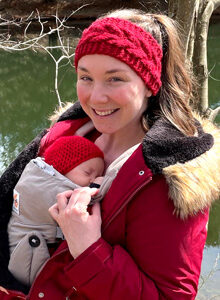Holistic health improves when children spend time playing outdoors (Dankiw et al., 2020; Gill, 2015; McQuay et al., 2020; McCormick, 2017). Children with autism spectrum disorder demonstrate increased world connections with outdoor sensory activities, as the natural environment affords more opportunities than a more sterile (i.e., hospital) or clinical environment (Figueroa, 2020). Natural environments improve interest, motivation, and participation in the difficult skills children are attempting to build; thereby promoting children and their families to experience the benefits of nature while meeting developmental and family-centered goals. The physical health, mental health, and social health benefits of nature exploration and suggested activities are described below.

Physical Health Benefits
Children’s physical health is affected by exposure to nature (Bonham-Corcoran et al., 2022; Coe et al., 2023; Dankiw et al., 2020; Figueroa, 2020; Gill, 2015; Hammell, 2021; Li et al., 2018; Mygind et al., 2019). The physiological benefits of time spent outdoors include decreased blood pressure and heart rate, improved oxygen saturation, increased physical abilities and fitness levels, improved health choices, and better sleep (Bonham-Corcoran et al., 2022; Firby & Raine, 2023; Mygind et al., 2019). Importantly, outdoor sensory activities offers unique opportunities to build the aforementioned skills through both structured and unstructured activities. While outside, children are able to take risks (i.e., jump over obstacles, climb trees, climb up muddy riverbanks, etc.), explore loose objects (i.e., stumps, rocks, fallen branches, etc.), and navigate creeks or other uneven terrains (i.e., sand, mud, fallen leaves, etc.). A beautiful benefit of nature exploration is that there are seasonal changes, allowing children to play in the snow and rain, further increasing opportunities to build strength, endurance, and balance (Figueroa, 2020).
Mental Health Benefits
People who spend time in nature have been found to report improved quality of life, valued hobbies, motivation, and newfound interests (Firby & Raine, 2023). Specifically for children, the mental and emotional benefits of nature include decreased stress, depression, anxiety, pain, fatigue, tension, and fear (Bonham-Corcoran et al., 2022; Kuo et al., 2018; Dopko et al., 2019). Moreover, time spent in nature improves attention, working memory, concentration, confidence, motivation (Kuo et al., 2018), self-esteem, positive self-identity (Bonham-Corcoran et al., 2022), and emotional regulation (Gill, 2015). When specifically examining children with autism spectrum disorder, Bradley and Male (2017) noted improved educational outcomes and enriched labeling and identification of emotions in natural environments. Similarly, Li and colleagues (2018) concluded that children with autism spectrum disorder demonstrated improved educational and therapeutic engagement, experienced genuine happiness, and overall improved interest and engagement while participating in outdoor sensory activities.
Social Well-Being Benefits
Spending time in nature leads to a sense of belonging and inclusivity (Firby & Raine, 2023); increased creative and cooperative play (Coe et al., 2023); positive relationships (Bonham-Corcoran, 2022); and improve self-control, self-awareness, and communication (Gill, 2015). When children engage in group play outdoors, they have increased opportunities for collaboration to solve problems presented by the environment (Dopko, et al., 2019). Rather than a caregiver leading social activities, children are able to seek support and ideas from each other on their own time, with the support of the caregiver as needed. This allows for a more natural initiation of social engagement, with the caregiver present to guide and coach rather than direct. One study found that when children on the autism spectrum engage in outdoor sensory activities, they were able to more accurately identify and name emotions both experienced and observed (Bradley & Male, 2017).
Integrating Outdoor Sensory Activities into Daily Life
The importance of engagement with nature cannot be overstated due to the opportunities it presents to enhance physical health, mental health, and social well-being. Many healthcare professionals can provide strategies and recommendations for nature exploration including occupational therapists. The ultimate goal of nature-based occupational therapy services is to promote daily life skills and foster development. Outside of structured therapeutic services, unstructured outdoor sensory activities encourages creativity, exploration, and ultimately a sense of independence.
More structured outdoor sensory activities include:
- Have a simple scavenger hunt by looking for birds, rocks, leaves, sticks, or items of interest to your child. This activity will target skills including attention, problem-solving, safety awareness, visual perceptual skills, identification of objects in the environment, social engagement, and many more. For added fine motor and visual motor skill components, write down or check off objects you find.
- Collect items found during a scavenger hunt or walk to create nature-based crafts such as leaf rubbings, nature collages, etc. Many children enjoy collecting items, and these outdoor sensory activities can expand upon the enjoyment of collecting objects to encourage further creativity as well as fine and visual motor skills.
- Take a family walk or hike or find a park to spend time in together. Simply be together. Let go of the pressure you may feel to entertain your children or to provide enrichment activities – allow your children and yourselves to simply enjoy being outdoors. Notice how this unstructured time affects everyone in the family.
- Schedule an unstructured outdoor play group with friends, look for local meet-up groups online, or create one yourself! Invite other families to meet up at a park or other outdoor location to allow the children to interact with and/or near one another. Do your best not to intervene unless there are safety concerns.
- Include your children in household tasks or chores such as lawn care, gardening, and animal care. These tasks not only involve children in the family culture and responsibilities, but target a multitude of skills previously mentioned.
- For cold climates, get creative! Bundle up and head outside for a bonfire, build snowmen, make snow angels, or have a snowball fight.
All of the aforementioned are suggestions to integrate outdoor sensory activities into daily life and can truly improve the well-being of children with autism spectrum disorder and their families as we can all benefit from time spent in nature.
Want more information? Contact Andrea Kormanik, OTD, OTR/L, at kormanika19@gmail.com for a free nature how-to handout.
References
Bonham-Corcoran, M., Armstrong, A., O’Briain, A., Cassidy, A., & Turner, N. (2022). The benefits of nature-based therapy for the individual and the environment: An integrative review. Irish Journal of Occupational Therapy, 50(1), 16-27. Doi: 10.1108/IJOT-06-2021-0015
Bradley, K., & Male, D. (2017). ‘Forest school is muddy and I like it’: Perspectives of young children with autism spectrum disorders, their parents, and educational professionals. Educational & Child Psychology, 34(2), 80-96.
Coe, D., Flynn, J., Wolff, D., Scott, S., & Dunham, S. (2014). Children’s physical activity levels and utilization of a traditional versus natural playground. Children, Youth and Environments 24(3), 1-15. https://doi.org/10.7721/chilyoutenvi.24.3.0001
Dankiw, K. A., Tsiros, M. D., Baldock, K. L., & Kumar, S. (2020). The impacts of unstructured nature play on health in early childhood development: A systematic review. PloS ONE, 15(2). https://doi.org/10.1371/journal.pone.0229006
Dopko, R., L., Capaldi, C. A., & Zelenski, J. M. (2019). The psychological and social benefits of a nature experience for children: A preliminary investigation. Journal of Environmental Psychology, 63, 134-138. https://doi.org/10.1016/j.jenvp.2019.05.002
Figueroa, L. P. (2020). Nature-based occupational therapy for children with developmental disabilities. SIS Quarterly Practice Connections, 5(3), 2–5.
Firby, H., & Raine, R. (2023). Engaging with nature and the outdoors: A scoping review of therapeutic applications in contemporary occupational therapy. Royal College of Occupational Therapists, 86(2), 101-115. Doi: 10.1177/03080226221126893
Gill, T. (2015). The benefits of children’s engagement with nature: A systematic literature review. Children, Youth and Environments, 24(2), 10–34. https://doi.org//10.7721/chilyoutenvi.24.2.0010
Hammell, K. (2021). Occupation in natural environments; Health equity and environmental
justice. Canadian Journal of Occupational Therapy, 88(4), 319–328. https://doi.org/10.1177/00084174211040000
Kuo, M., Browning, M. H. E. M., & Penner, M. L. (2018). Do lessons in nature boost subsequent classroom engagement? Refueling students in flight. Frontiers in Psychology, 8, 2253. https://doi.org/10.3389/fpsyg.2017.02253
Li, D., Larsen, L., Yang, Y., Wang, L., Zhai, Y., & Sullivan, W. C. (2018). Exposure to nature for children with autism spectrum disorder: Benefits, caveats, and barriers. Health & Place, 55, 71–79. https://doi.org/10.1016/j.healthplace.2018.11.005
McCormick, R., (2017). Does access to green space impact the mental well-being of children: A systematic review. Journal of Pediatric Nursing, 37, 3–7. https://doi.org/10.1016/j.pedn.2017.08.027
McQuay, C., Olmstead, C., Reamy, T., Richardson, E., & Koslow, R. (2020). Exploring the impact of nature-based intervention on the physiology, emotions, and ability to self-regulate in at-risk preadolescent youth. American Journal of Occupational Therapy, 74(4), 7411515348. https://doi.org/10.5014/ajot.2020.74S1-PO1133
Mygind, L., Kjeldsted, E., Hartmeyer, R., Mygind, E., Bolling, M., & Bentsen, P. (2019). Mental, physical and social health benefits of immersive nature-experience for children and adolescents: A systematic review and quality assessment of the evidence. Health & Place, 58, 102136. https://doi.org/10.1016/j.healthplace.2019.05.014






